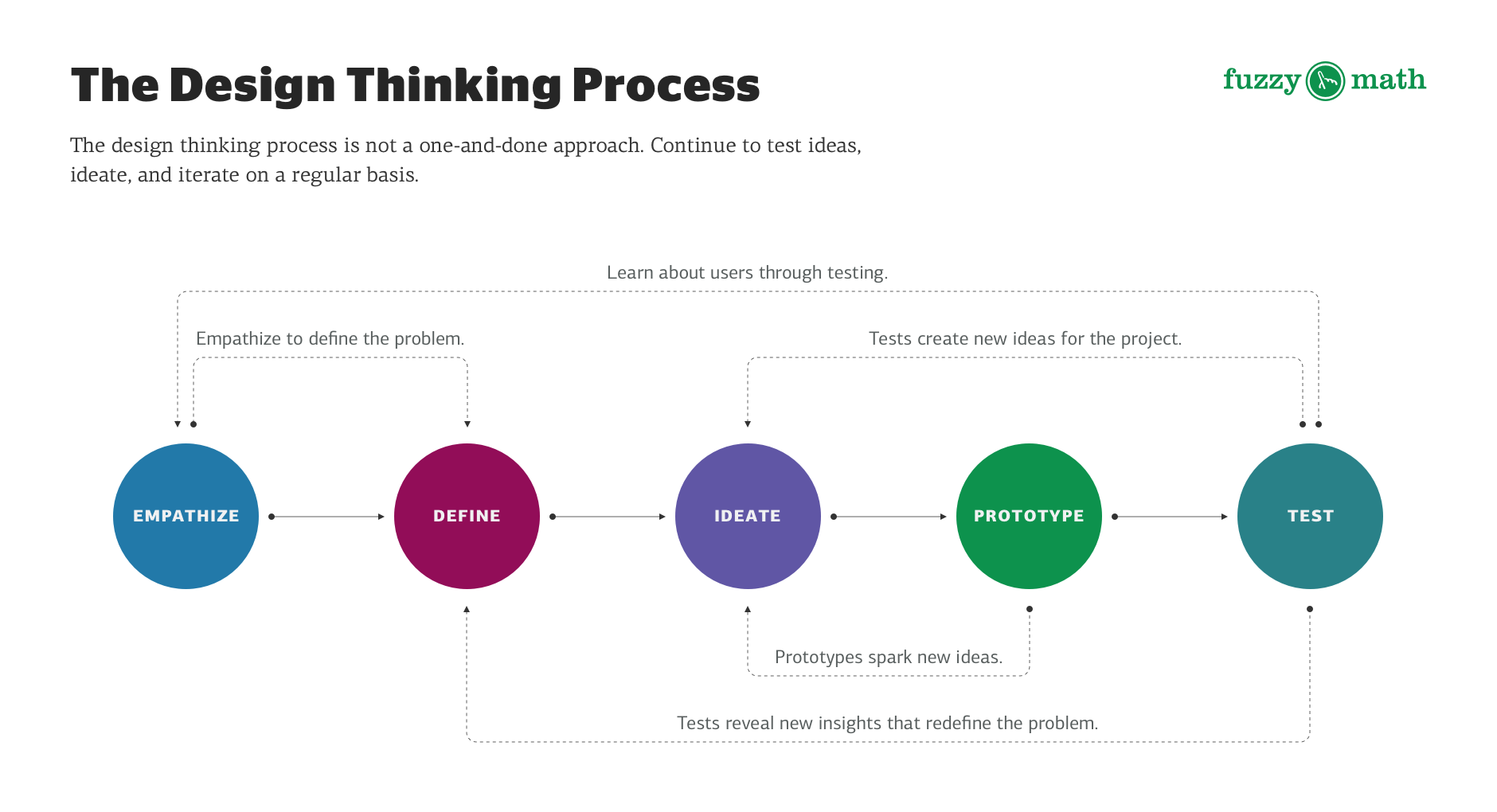
The term “design thinking” has been popularized over the past decade and used in a variety of contexts. While just the sound of it may make it seem like it’s strictly relegated to the design world, the design thinking process can be applied to just about any field.
First, we should note that while we use the phrase “design thinking” throughout this article, here at Fuzzy Math we avoid using it altogether. Essentially, we have found that the phrase is oftentimes confusing and doesn’t quite have a clear meaning. Instead, we usually opt for phrases like human-centric or user-centered design process, because they simplify the concept and make it easier to understand. However, since most people are now familiar with “design thinking”, we’re here to help you better understand the fundamentals. To do that we put together this guide so you can start implementing the design thinking approach in your everyday work.
What is design thinking?
Put simply, design thinking is the application of the human-centered design process to solve business problems. The outcome of going through the design thinking process could lead to broader solutions for a business, including things like a more streamlined flow of communication between employees and upper management, the development of internal accountability committees, and so much more.
There are five steps in the human-centered design thinking process: empathize, define, ideate, prototype, and test.

Step 1: Empathize
In the empathize stage, all of your exploration and discovery happens. For UX designers, this includes things like user research and competitive analysis. For business leaders, this could be in the form of a company-wide employee survey or conducting employee focus groups. Essentially, this is the part of the process where you work to understand the problem at hand in order to then figure out what you should be solving. During this phase, it is important to understand who your specific user (or customer or employee) is and step into their shoes. Understand their point of view—what they’re doing, how they’re feeling, and what issues they may have.
Step 2: Define
The next step of the process is the define stage. Here, designers process, analyze, and gain an overall better understanding of the research gathered. Here, you work to define the problem and clearly understand the who, what, when, and why of the situation. In the empathize stage, you learned about your audience through your research. Now it’s time to focus in on that audience.
It would be impossible to find any solutions if you were to empathize with everyone, so defining a target group is essential. Sometimes it’s even helpful to explicitly state who you are not focusing on to really hone in on your audience. In design work, this is important to narrow the scope and align the team on who the most important user is. For example, we’ve chosen to actively not design health trackers for a healthy population or shipment reporting tools for the drivers of the truck being unloaded. But don’t be so quick to rule out a group of people! That’s why we put this in the define stage. Make sure to do your research and understand who they are and what they require before working to narrow down your target audience.
Now that you have your target audience, focus on their goals and recognize what is standing in their way to get there. It’s not about the demographic makeup of our audience (e.g. gender, age, socioeconomic status) so much as it is about their objectives (e.g. junior-level employees want more mentorship opportunities with senior leadership). Although you may start the design thinking process with a problem you are looking to solve for already, the empathize and define phases usually reveal an unrealized problem at hand. Uncovering this nugget is one of the most fun parts of the job (in our opinion), so don’t be afraid to get in there and dig towards what’s really going on.
Step 3: Ideate
The next stage is ideation. In the world of UX design, this is where we will use the information learned in previous stages to brainstorm, generate ideas, and whip up concepts for how the final product will function and what it will look like. For businesses applying the design thinking methodology, the ideation phase often involves drafting up ideas for new company initiatives or policies that would bring impactful, positive change to the organization.
We like to include our clients in our ideation workshops — but not just our main contact or small project team! People from the C-suite down to service centers all have their own points of view of the problems and potential solutions. We invite them to contribute their ideas and work hard to keep them focused on what we have previously defined as the problem(s) to solve. The same should be done when solving business problems through design thinking. By involving a wide variety of voices in the ideation process, you can achieve a greater breadth of ideas and come up with new strategies or concepts that your core team would otherwise never have thought of.
Step 4: Prototype
Next, you must build something in order to learn from it. In the prototype stage, the solution to the previously identified problem is developed. Here, we use all of the knowledge and empathy that we’ve gained from user research, combined with our knowledge of best practices, to craft a new sitemap or design a new, actionable dashboard where users can see everything that’s going on in their system. It doesn’t have to (and probably shouldn’t!) be fully built out or “perfect”. Prototypes are inexpensive, scaled-down versions of the final product that help designers investigate ideas generated during the ideation stage. It’s the design thinking way of getting something real that you can bring to users in the next step.
From a business perspective, this could look like drafting a new company mentorship program or a plan to prioritize funding for junior staff members to pursue professional development opportunities.
Step 5: Test
And finally, the most important step of the design thinking process: the testing phase. What elements are meeting the needs of your users? What needs to be readdressed?
Although the design thinking process is broken up into these five stages of design that are often illustrated in a linear pattern, the approach is actually quite iterative. It is common for projects utilizing the design thinking approach to go through steps and back and forth again in order to account for new information gained. For instance, the ideation phase could reveal that there was a major question unanswered in the empathize stage, so it would only make sense to go back to do more research to make sure that the final product may actually be addressing the problem you are trying to solve.
Continue to test your ideas, ideate, and iterate on a regular basis moving forward. The design thinking approach is not a one-and-done idea. After all, it may take several rounds of drafting, refining, and executing to determine what resonates with your users and what needs additional work. As long as you’re continually making adjustments to make sure that your plan, business, or product is continuing to meet the needs of your users, your first draft is just your first step down a new path forward.
How design thinking can help your business
At the end of the day, the design thinking process helps businesses by focusing on the users and allows business leaders to better identify, understand, and address the problems at hand. You start with the needs of people, of clients, of employees. Only then do you work on solutions.
Collaborative processes stick around.
By engaging with people with different perspectives, businesses can draw upon their collective experience to solve problems. Anyone at a company can (and maybe should) participate in the process. This inter-company collaboration can set your business up for success by allowing for creativity and new ideas that hadn’t previously been explored. Plus, when employees (and users) have a chance to have their voice be heard, they often feel a sense of ownership over the solution and are more likely to stick around because of it.
It’s okay to “fail,” because you’re already planning to try again
Failure is an option. It takes a huge effort to put something new out into the world, and a lot of businesses are terrified of failure. In turn, this fear leads them to inaction—they sit idle while other businesses pass them by. The design thinking process of ideating, testing, and iterating can help break that cycle. You expect to gather feedback. You expect to hear that something didn’t work how you intended. So you go back to the drawing board, and you try again, and that’s okay! That’s the magic of the design thinking approach.
Design thinking is trainable
Plus, design thinking is trainable! Whether you’re looking to apply design thinking to design teams or looking to learn more about the UX process in other areas of your business, Fuzzy Math’s UX training services have helped clients large and small to prove the value of design thinking across business areas. We’ve worked to define cross-functional processes and structures that position design thinking in a way that makes meaningful improvements specific to your organization, products and services.
How to implement design thinking at your company
For business leaders interested in using the design thinking process at their companies, it is important to remember to look at design thinking as more than just a process — it’s a state of mind. A chance to empathize with colleagues and use the creative process to identify solutions for change. In the article “Why Design Thinking Initiatives Fail”, Anthony Pannozzo encapsulates this idea perfectly by writing, “Focusing on process alone will not nurture empathy and creativity. And it certainly won’t nurture optimism.” He goes on to write how these initiatives need to address the pessimism that often comes along with doing these workshops, and for leaders to genuinely invest in listening and understanding in order to create real change.
As a leader seeking to champion the design process, you must be dedicated to the process in order to reap the rewards. It bears repeating that this is not a transactional process that is one-and-done. Instead, design thinking is a different way of continually operating to make sure everyone is heard and part of the solutions at their organizations.
Ready to learn more about how user-centered design and design thinking can make an impact at your company? Get in touch to learn more about Fuzzy Math’s UX and Design Thinking Training, and get a custom proposal for your UX Workshop.